The global sound intensity microphone market is forecast to reach USD 170.7 million by 2035, reflecting an absolute increase of USD 79.8 million over the forecast period. The market, valued at USD 90.9 million in 2025, is expected to grow at a CAGR of 6.5%. This growth is primarily driven by increasing demand for high-precision sound-intensity measurement instruments across industries such as audio recording, telecommunications, environmental monitoring, and automotive applications, where accurate sound-level detection and analysis are critical.
Sound intensity microphones are designed to measure sound pressure and particle velocity in order to calculate the direction and magnitude of sound energy in a given space. These microphones are widely used in sound engineering, noise control, and acoustic research. With the growing emphasis on reducing noise pollution, improving sound quality, and advancing audio technology, demand for high-performance microphones capable of precise sound-intensity measurements is expected to increase. The integration of advanced technologies, such as wireless communication and automation, into microphone systems is driving the adoption of sound-intensity microphones across industries, from automotive to healthcare.
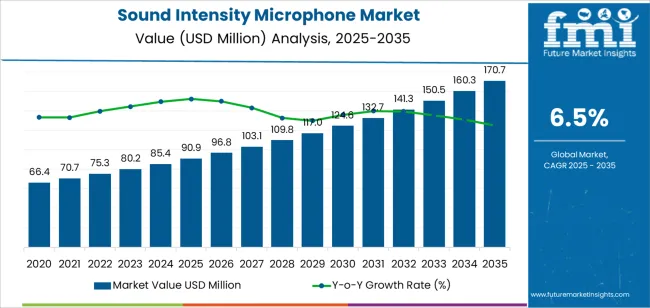
The increasing focus on noise reduction in urban environments, the need for better hearing protection in industrial applications, and the development of more advanced soundproofing materials in construction and manufacturing are contributing to the market's growth. With the rise of consumer audio products, including noise-canceling headphones and high-definition audio devices, demand for sound intensity measurement tools is also increasing to ensure that these products meet the desired audio quality and performance standards.
Technological advancements are also playing a crucial role in market expansion. For instance, improvements in microphone materials, data processing, and wireless connectivity are enhancing the efficiency and performance of sound intensity microphones. These innovations allow for more accurate sound measurements, greater convenience, and integration into automated systems, further boosting the market's growth prospects.
Between 2025 and 2030, the sound intensity microphone market is projected to grow from USD 90.9 million to approximately USD 121.0 million, adding USD 30.1 million, which accounts for about 37.7% of the total forecasted growth for the decade. This period will see increasing adoption of sound intensity microphones in audio engineering, environmental monitoring, and noise control applications, as industries strive to meet regulatory standards and improve audio performance.
From 2030 to 2035, the market is expected to expand from approximately USD 121.0 million to USD 170.7 million, adding USD 49.7 million, which constitutes about 62.3% of the overall growth. This phase will be marked by ongoing advancements in audio technologies, particularly in high-definition sound recording, automotive acoustic systems, and healthcare applications, where sound intensity microphones will play a critical role in product development, testing, and performance optimization.
| Metric | Value |
|---|---|
| Market Value (2025) | USD 90.9 million |
| Market Forecast Value (2035) | USD 170.7 million |
| Forecast CAGR (2025 to 2035) | 6.5% |
The sound intensity microphone market is experiencing growth due to the increasing demand for precise and high-quality sound measurement in a variety of applications, including acoustics research, environmental noise monitoring, and industrial sound analysis. Sound intensity microphones are used for accurately measuring the intensity of sound in different environments, making them essential tools in noise control engineering, building acoustics, and product testing. These microphones provide valuable data on sound levels, helping to improve product designs and reduce unwanted noise.
The growing focus on environmental noise pollution and the need for noise regulation in urban areas are driving the demand for sound intensity microphones. As cities and industries strive to reduce noise pollution, these microphones are increasingly used in environmental monitoring, urban planning, and construction to ensure compliance with noise regulations. The rise of the automotive and consumer electronics industries is contributing to market growth, as manufacturers use sound intensity microphones to evaluate and enhance the acoustic performance of their products.
Advancements in microphone technology, such as improvements in sensitivity, accuracy, and noise reduction capabilities, are also propelling the market. The growing trend of smart devices and their integration into consumer products has led to a need for better sound quality, further boosting the demand for sound intensity microphones in testing and quality control processes. Challenges related to high costs and the complexity of using advanced measurement systems may limit adoption in some industries. Despite these obstacles, the market is expected to grow as the demand for accurate sound measurement and noise control continues to rise.
The market is segmented by type, application, and region. By type, the market is divided into fully-automatic and semi-automatic systems, with fully-automatic systems leading the market. Based on application, the market is categorized into skin care products, hair care products, oral care products, and others. Regionally, the market is divided into Asia Pacific, Europe, North America, and other key regions.

The fully-automatic segment dominates the personal care products filling system market, accounting for 45.0% of the total market share. This growth is primarily driven by the increasing demand for high-efficiency, high-speed, and precise filling systems in the personal care industry. Fully-automatic systems are capable of handling large production volumes with minimal human intervention, offering advantages in terms of speed, consistency, and accuracy. These systems are particularly well-suited for manufacturers aiming to meet the growing demand for personal care products while maintaining high standards of product quality and safety.
Fully-automatic filling systems can be easily integrated into existing production lines, allowing for seamless operation and reduced labor costs. As the personal care industry continues to focus on scalability and production efficiency, fully-automatic systems are expected to maintain their dominance, particularly in large-scale manufacturing environments. Their ability to handle diverse product formulations and packaging types further strengthens their appeal in the competitive personal care market.
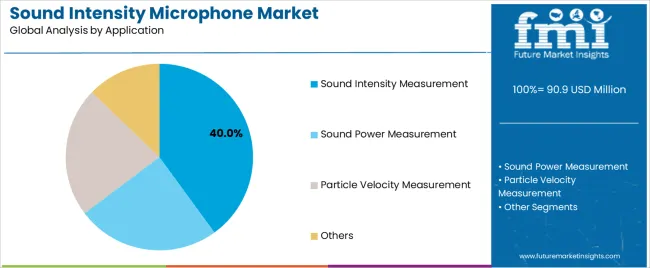
The skin care products application segment leads the personal care products filling system market, holding 40% of the total market share. This dominance is driven by the rising global demand for skincare products, which continues to outpace other personal care categories. As consumer preferences shift toward health and wellness, the demand for skincare products such as lotions, creams, serums, and gels has surged. This growth is accompanied by the need for efficient and reliable filling systems capable of handling a wide range of formulations and packaging types.
Filling systems, particularly fully-automatic systems, are critical in the production of these products, ensuring accurate measurements, consistency, and contamination control. The expanding skincare industry, fueled by increasing awareness of skincare benefits and a rising demand for natural and organic formulations, is driving the adoption of advanced filling technologies. As manufacturers look to meet both the scale and the quality requirements of skincare product production, the filling system market for skin care products is expected to continue to grow at a significant rate, securing its position as the largest application segment.
The market for sound intensity microphones is growing as demand rises in acoustic engineering, industrial noise monitoring, and architectural sound‑power testing. As industries adopt stricter noise‑emission standards and advanced sound‑mapping tools, these microphones offer enhanced measurement accuracy, driving demand. Challenges such as high device cost, complex calibration requirements, and niche awareness limit broader adoption.
Sound intensity microphones are gaining popularity because they enable detailed acoustic diagnostics providing not only sound pressure levels but also sound power and direction of sources. This capability is essential in environments where traditional pressure microphones aren’t sufficient, such as complex machinery, HVAC systems, or industrial equipment enclosures. As noise regulations tighten and companies aim to mitigate sound footprint or improve product design, the advanced insights these microphones deliver become invaluable. Their ability to identify sound leaks, map acoustic fields, and support compliance efforts makes them highly useful in sound engineering workflows.
Technological innovations are enhancing the sound intensity microphone segment by improving accuracy, ease of use, and data integration. Developments include sensor pairs with precise phase matching, compact probes compliant with IEC 61043 standards, and ruggedized designs optimized for harsh industrial settings. Advanced signal processing and connectivity with analytics platforms allow real‑time sound‑intensity mapping and remote monitoring. These improvements reduce setup time and increase measurement reliability, broadening applications from laboratory environments into field and production‑floor use. As feature enhancements continue, the usability and value proposition of sound intensity microphones expand, supporting wider adoption.
Despite strong benefits, sound intensity microphones face several adoption hurdles. The high cost and technical complexity limit usage primarily to specialized labs and large industrial users. Proper calibration and the need for trained acousticians to handle dual‑sensor setups add expense and time. Many potential users lack awareness of the distinct benefits over standard pressure microphones, reducing demand. Standardization issues and lack of unified protocols for intensity‑based measurement in many regions limit the perceived value. Overcoming these barriers is essential for broader market penetration.
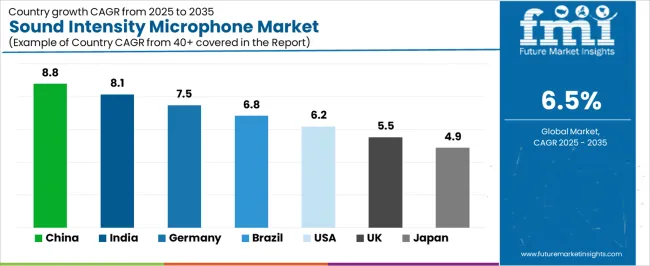
| Country | CAGR (%) |
|---|---|
| China | 8.8% |
| India | 8.1% |
| Germany | 7.5% |
| Brazil | 6.8% |
| USA | 6.2% |
| UK | 5.5% |
| Japan | 4.9% |
The sound intensity microphone market is showing robust growth prospects across major regions. China leads at an 8.8% CAGR, driven by expanding telecommunication networks, audio‑measurement needs, and industrial acoustics applications. India follows with an 8.1% CAGR, supported by a rising broadcast/media sector and acoustic measurement standards.
Germany records a 7.5% CAGR, anchored by its strong industrial base and demand for high‑precision microphone instrumentation. Brazil grows at 6.8% as infrastructure and audio broadcast investment rises. The USA shows a 6.2% CAGR, driven by professional audio, measurement instrumentation and live broadcast needs. The UK and Japan show moderate growth at 5.5% and 4.9% respectively, reflecting mature markets with steady demand for advanced measurement microphones.
China is leading the sound intensity microphone market with a growth rate of 8.8% CAGR, driven by the country’s large and rapidly growing industrial sector, especially in automotive, electronics, and telecommunications. The demand for high-precision microphones is rising in the automotive and manufacturing sectors, where noise, vibration, and harshness (NVH) testing are essential for ensuring product quality. As China continues to develop its industrial infrastructure, the need for sound intensity measurement in both consumer electronics and industrial products increases.
The country's strong emphasis on environmental regulations has also pushed the adoption of sound intensity microphones, particularly in measuring environmental noise in urban planning and infrastructure projects. The growing broadcasting and live event sectors are boosting the demand for high-quality sound measurement tools. China’s large research and development (R&D) base, supported by government funding, is fostering innovation in microphone technologies, making them more accessible and cost-effective.
The growing focus on high-performance audio systems in consumer electronics, such as smartphones, speakers, and automotive systems, further stimulates the demand for sound intensity microphones. As China strengthens its position as a global leader in manufacturing and technology innovation, the sound intensity microphone market in the country is poised for continued growth.
India is showing strong demand for sound intensity microphones with a growth rate of 8.1% CAGR, driven by a burgeoning entertainment, media, and manufacturing sector. The increasing adoption of high-definition audio systems, coupled with rapid growth in broadcast and live event production, has led to greater demand for precision sound measurement tools. In particular, India’s expanding film industry and the rise of digital streaming platforms contribute to the growth of the audio measurement market, where sound intensity microphones are essential for ensuring clear and accurate sound reproduction.
India’s industrial sector is evolving, with more factories and production facilities investing in noise-control systems to comply with stricter environmental regulations. As manufacturing quality becomes more focused on precision, the need for sound intensity microphones in quality control and NVH testing has grown. The demand for these microphones is further accelerated by India’s investment in infrastructure and transportation projects, which require sound intensity measurement for environmental noise monitoring.
The increasing awareness of noise pollution, combined with the rising use of smart devices and automotive technologies, is also contributing to the adoption of sound intensity microphones in India. As the country continues to invest in its industrial and research sectors, this market is expected to continue growing at a strong pace.
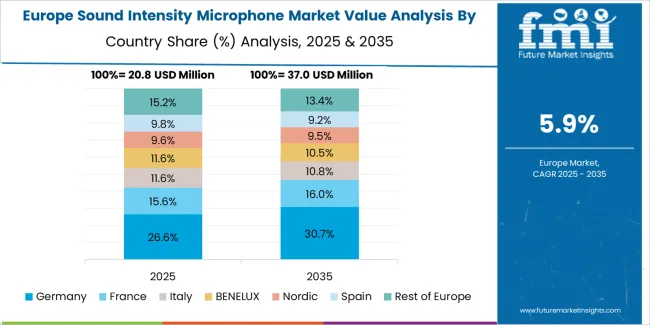
Germany is seeing steady growth in the sound intensity microphone market, with a 7.5% CAGR, driven by its strong industrial base, high demand for acoustic measurement tools, and reputation for precision engineering. Germany’s automotive industry, one of the largest in the world, extensively uses sound intensity microphones in NVH testing to ensure product reliability and compliance with strict noise standards. These microphones are crucial in evaluating vehicle components, including engines, exhaust systems, and interiors, for noise emissions and vibrations.
Germany’s strong presence in research and development in the field of acoustics and audio systems also contributes to the demand for sound intensity microphones. Universities and technical institutes in Germany are at the forefront of audio research, using sound intensity microphones in their projects related to environmental noise, noise pollution control, and sound measurement technology development. The German government’s focus on sustainability and regulatory standards for industrial noise further boosts the need for these devices in sectors like construction, aerospace, and consumer electronics.
Germany’s well-developed broadcast and live entertainment industries, along with its commitment to precision in audio technologies, ensures that the country remains a key contributor to the global sound intensity microphone market. The demand for high-precision, reliable measurement systems will continue to drive market growth in Germany.
Brazil is experiencing steady growth in the sound intensity microphone market, with a 6.8% CAGR, driven by the expansion of its infrastructure, automotive, and entertainment sectors. Brazil’s growing investments in public works, such as roads, airports, and metro systems, have increased the demand for noise measurement tools to comply with environmental regulations. Sound intensity microphones are crucial in evaluating noise pollution levels and ensuring compliance with noise control standards in urban development projects.
The demand for these microphones is also fueled by Brazil’s expanding automotive sector, which requires NVH testing to ensure the quality and comfort of vehicles. As the country’s automotive industry grows and adopts higher standards for soundproofing and noise regulation, sound intensity microphones are becoming essential tools in quality control and product testing. Brazil’s booming media and entertainment industries, including live events, broadcasting, and music production, are increasingly adopting advanced sound measurement technologies to enhance audio quality and ensure precise sound reproduction.
With the growing awareness of environmental noise pollution and the need for high-quality sound systems, Brazil is seeing a steady rise in demand for sound intensity microphones. As the country continues to modernize its infrastructure and industrial sectors, the market for these tools is expected to keep expanding.
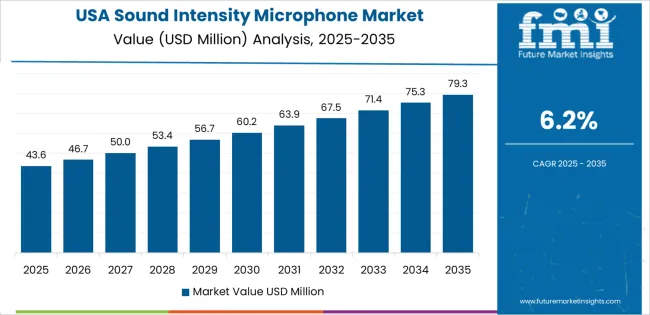
The USA is experiencing a 6.2% CAGR in the sound intensity microphone market, driven by its advanced industrial sectors, strong research and development infrastructure, and widespread use of these microphones in professional audio, automotive, and environmental applications. The USA’s automotive industry extensively uses sound intensity microphones for NVH testing to ensure high-quality vehicles meet stringent noise regulations. These microphones are also in demand for aerospace testing, where noise emissions and vibrations need to be controlled for safety and comfort.
The USA’s thriving entertainment and media sectors contribute significantly to the demand for sound intensity microphones. Professional audio systems used in music production, concerts, and broadcasting require precise sound measurements, driving the adoption of high-performance microphones. The rise in live-streaming events and digital content creation further accelerates demand in the professional audio market.
The growing focus on noise pollution control in urban areas and industrial zones, along with the demand for high-precision microphones in environmental monitoring, also contributes to the growth of this market. The USA’s continued investment in technology, along with regulatory pressure to reduce noise pollution, will ensure steady growth in the sound intensity microphone sector.
The UK is showing moderate demand in the sound intensity microphone market, with a 5.5% CAGR, supported by its well-established entertainment, media, and industrial sectors. The country’s broadcast and live event industries are major drivers of the market, where high-quality microphones are essential for ensuring accurate sound reproduction in both production and performance settings. The UK’s focus on high-end audio systems for cinema, television, and music production is a key factor pushing demand for precision microphones.
The automotive and manufacturing industries in the UK are also increasingly using sound intensity microphones for NVH testing and to meet noise control standards. The country’s commitment to improving its environmental policies, particularly in urban areas, further drives the adoption of these microphones for environmental noise monitoring.
The UK’s steady demand for sound intensity microphones is supported by its reputation for high-quality audio equipment, regulatory standards, and continued investments in the media and entertainment sectors. As the UK focuses on reducing environmental noise pollution and ensuring high-quality sound systems, the market for these microphones is expected to maintain moderate growth.
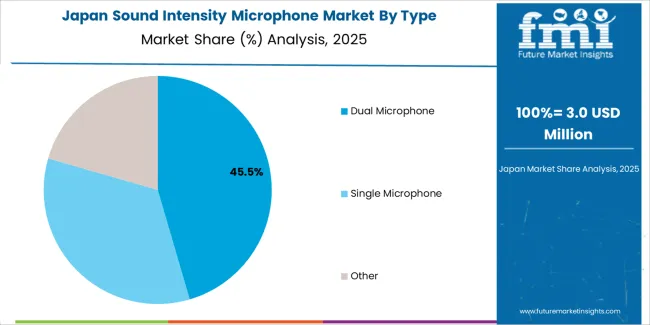
Japan is witnessing steady demand in the sound intensity microphone market, with a 4.9% CAGR, driven by its strong presence in the automotive, consumer electronics, and research sectors. Japan’s automotive industry uses sound intensity microphones for NVH testing to improve vehicle comfort and reduce noise pollution. As Japan leads in developing smart technologies and autonomous vehicles, the demand for precise sound measurement tools will continue to rise.
Japan’s consumer electronics sector also contributes to the demand for sound intensity microphones, as manufacturers use these devices for product testing, including sound quality assessment in audio systems, speakers, and mobile devices. Japan’s growing focus on environmental noise control in urban planning and transportation systems is boosting the use of these microphones in noise pollution monitoring.
With Japan’s continued commitment to technological innovation and high-quality manufacturing, the market for sound intensity microphones will experience steady growth. Although Japan’s market is more mature compared to other regions, its emphasis on quality control and precision ensures the continued adoption of sound intensity microphones.
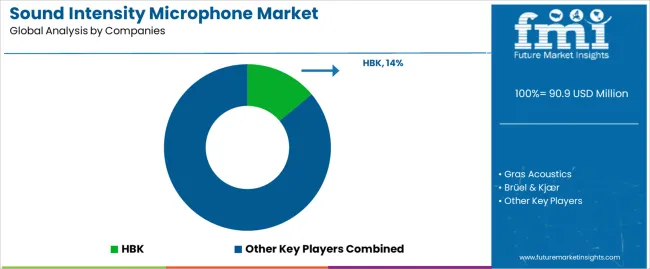
The sound intensity microphone market is specialized, catering to the growing need for precise acoustic measurement tools used in sound intensity testing across various industries, including automotive, aerospace, and industrial applications. HBK leads the market with a 14% share, recognized for its advanced acoustic measurement systems, including sound intensity microphones. HBK’s strong reputation for high-quality instrumentation, precision engineering, and comprehensive solutions for sound and vibration measurement gives it a dominant position in the market.
Other major players include Gras Acoustics, Brüel & Kjær, and PCB Piezotronics, all of which are highly regarded for their expertise in the field of sound measurement. Gras Acoustics is known for providing innovative and reliable sound intensity microphones used in diverse testing environments, from automotive acoustics to environmental noise analysis. Brüel & Kjær offers a broad range of advanced measurement equipment, including precision microphones and systems designed for high-accuracy sound intensity analysis. PCB Piezotronics focuses on delivering sound intensity microphones and measurement solutions that meet the needs of both industrial and scientific sectors.
Companies like 01dB (Acoem Group), Microflown Technologies, and Norsonic contribute to the market with specialized products that integrate cutting-edge technologies for advanced sound intensity testing. ACO Pacific, Casella, and Sinus Messtechnik are also key players, providing high-quality microphones and measurement solutions designed for acoustic testing in professional and research settings. ONO SOKKI rounds out the competition with its focus on precision measurement instruments for sound intensity and other acoustical properties.
The competition in this market is driven by advancements in acoustic testing technology, with a strong emphasis on accuracy, reliability, and ease of use in various environments. As demand for high-precision sound measurement tools increases, companies continue to innovate, providing high-performance microphones that meet evolving industry requirements.
| Items | Values |
|---|---|
| Quantitative Units (2025) | USD million |
| Type | Dual Microphone, Single Microphone, Other |
| Application | Sound Intensity Measurement, Sound Power Measurement, Particle Velocity Measurement, Others |
| Regions Covered | Asia Pacific, Europe, North America, Latin America, Middle East & Africa |
| Countries Covered | China, Japan, South Korea, India, Australia & New Zealand, ASEAN, Rest of Asia Pacific, Germany, United Kingdom, France, Italy, Spain, Nordic, BENELUX, Rest of Europe, United States, Canada, Mexico, Brazil, Chile, Rest of Latin America, Kingdom of Saudi Arabia, Other GCC Countries, Turkey, South Africa, Other African Union, Rest of Middle East & Africa |
| Key Companies Profiled | HBK (formerly Brüel & Kjær), Gras Acoustics, Brüel & Kjær, PCB Piezotronics, 01dB (Acoem Group), Microflown Technologies, Norsonic, ACO Pacific, Casella, Sinus Messtechnik, ONO SOKKI |
| Additional Attributes | Dollar sales by type and application categories, market growth trends, market adoption by classification and application segments, regional adoption trends, competitive landscape, advancements in intensity microphone technologies, integration with sound measurement systems. |
The global sound intensity microphone market is estimated to be valued at USD 90.9 million in 2025.
The market size for the sound intensity microphone market is projected to reach USD 170.7 million by 2035.
The sound intensity microphone market is expected to grow at a 6.5% CAGR between 2025 and 2035.
The key product types in sound intensity microphone market are dual microphone, single microphone and other.
In terms of application, sound intensity measurement segment to command 40.0% share in the sound intensity microphone market in 2025.






Our Research Products

The "Full Research Suite" delivers actionable market intel, deep dives on markets or technologies, so clients act faster, cut risk, and unlock growth.

The Leaderboard benchmarks and ranks top vendors, classifying them as Established Leaders, Leading Challengers, or Disruptors & Challengers.

Locates where complements amplify value and substitutes erode it, forecasting net impact by horizon

We deliver granular, decision-grade intel: market sizing, 5-year forecasts, pricing, adoption, usage, revenue, and operational KPIs—plus competitor tracking, regulation, and value chains—across 60 countries broadly.

Spot the shifts before they hit your P&L. We track inflection points, adoption curves, pricing moves, and ecosystem plays to show where demand is heading, why it is changing, and what to do next across high-growth markets and disruptive tech

Real-time reads of user behavior. We track shifting priorities, perceptions of today’s and next-gen services, and provider experience, then pace how fast tech moves from trial to adoption, blending buyer, consumer, and channel inputs with social signals (#WhySwitch, #UX).

Partner with our analyst team to build a custom report designed around your business priorities. From analysing market trends to assessing competitors or crafting bespoke datasets, we tailor insights to your needs.
Supplier Intelligence
Discovery & Profiling
Capacity & Footprint
Performance & Risk
Compliance & Governance
Commercial Readiness
Who Supplies Whom
Scorecards & Shortlists
Playbooks & Docs
Category Intelligence
Definition & Scope
Demand & Use Cases
Cost Drivers
Market Structure
Supply Chain Map
Trade & Policy
Operating Norms
Deliverables
Buyer Intelligence
Account Basics
Spend & Scope
Procurement Model
Vendor Requirements
Terms & Policies
Entry Strategy
Pain Points & Triggers
Outputs
Pricing Analysis
Benchmarks
Trends
Should-Cost
Indexation
Landed Cost
Commercial Terms
Deliverables
Brand Analysis
Positioning & Value Prop
Share & Presence
Customer Evidence
Go-to-Market
Digital & Reputation
Compliance & Trust
KPIs & Gaps
Outputs
Full Research Suite comprises of:
Market outlook & trends analysis
Interviews & case studies
Strategic recommendations
Vendor profiles & capabilities analysis
5-year forecasts
8 regions and 60+ country-level data splits
Market segment data splits
12 months of continuous data updates
DELIVERED AS:
PDF EXCEL ONLINE
Sound Meter Market Size and Share Forecast Outlook 2025 to 2035
Sound Barriers Market Size and Share Forecast Outlook 2025 to 2035
Sound Level Measurement Meter Market Size and Share Forecast Outlook 2025 to 2035
Soundproof Drywall Materials Market Size and Share Forecast Outlook 2025 to 2035
Sound Reinforcement Market Size and Share Forecast Outlook 2025 to 2035
Sound Level Meter Market Size and Share Forecast Outlook 2025 to 2035
Sound Sensor Market Analysis by Type, Technology, Specification, and Region Through 2035
Utrasound Doppler Market Size and Share Forecast Outlook 2025 to 2035
Ultrasound Conductivity Gels Market Size and Share Forecast Outlook 2025 to 2035
Ultrasound Market Size and Share Forecast Outlook 2025 to 2035
Ultrasound Skin Tightening Devices Market Size and Share Forecast Outlook 2025 to 2035
Ultrasound Biometry Devices Market Size and Share Forecast Outlook 2025 to 2035
Ultrasound Devices Market Size and Share Forecast Outlook 2025 to 2035
Ultrasound-Guided Breast Biopsy Market Size and Share Forecast Outlook 2025 to 2035
Echo Sounders Market Insights - Demand, Size & Industry Trends 2025 to 2035
Ultrasound Systems Market Growth – Trends & Forecast 2025-2035
Ultrasound Imaging Solution Market
Teleultrasound Systems Market
Food Ultrasound Market Analysis – Applications & Innovations 2025 to 2035
Automotive Sound Proofing Material Market

Thank you!
You will receive an email from our Business Development Manager. Please be sure to check your SPAM/JUNK folder too.
Chat With
MaRIA